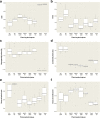Combining deep-inspiration breath hold and intensity-modulated radiotherapy for gastric mucosa-associated lymphoid tissue lymphoma: Dosimetric evaluation using comprehensive plan quality indices
- PMID: 30961618
- PMCID: PMC6454700
- DOI: 10.1186/s13014-019-1263-7
Combining deep-inspiration breath hold and intensity-modulated radiotherapy for gastric mucosa-associated lymphoid tissue lymphoma: Dosimetric evaluation using comprehensive plan quality indices
Abstract
Background: Although there have been many attempts to increase the therapeutic ratio of radiotherapy for gastric mucosa-associated lymphoid tissue lymphoma (MALToma), only a few planning studies have reported the efficacy of the modern radiotherapy technique till date. Therefore, we performed the dosimetric comparison among 3-dimensional conformal radiotherapy (3D-CRT) and intensity-modulated radiotherapy (IMRT) plans, using deep-inspiration breath hold (DIBH) or free-breathing (FB) techniques, to determine the most optimal plan for gastric MALToma.
Methods: We evaluated 9 patients with gastric MALToma for whom 3D-CRT, step-and-shoot IMRT (SIMRT), volumetric-modulated arc therapy (VMAT), and tomotherapy plans with identical prescribed doses were generated using DIBH or FB computed tomography (CT). Planning target volume (PTV) coverage and non-target doses were calculated for each plan and compared with plan quality metric (PQM) scores.
Results: All 72 plans of 9 patients satisfied our dosimetric goals, and the IMRT plans and 3D-CRT plans had similarly good conformity index values with no differences related to respiratory movement. IMRT plans yielded significantly better doses to the organs-at-risk, and DIBH plans yielded significantly lower liver, heart, and lung Dmean and spinal cord Dmax with smaller irradiated volumes compared to FB plans. For the mean PQM scores, VMAT-DIBH and SIMRT-DIBH yielded the best scores, whereas 3D plans provided reduced beam monitor unit values.
Conclusion: Our findings demonstrate that modern RT technologies (DIBH with VMAT or SIMRT) could potentially provide excellent target coverage for gastric MALToma while reducing doses to organs-at-risk. However, the relevance of the most optimal plan considering clinical outcomes should be confirmed further in a larger patient cohort.
Keywords: Deep inspiration breath hold; Intensity modulated radiotherapy; Mucosa-associated lymphoid tissue lymphoma; Planning study; Radiotherapy.
Conflict of interest statement
Ethics approval and consent to participate
This study was approved by Institutional review board (IRB) of Yonsei University Health System (4–2017-1035). The patient records/information was anonymized and de-identified prior to analysis, and informed consent was not obtained from each participants.
Consent for publication
Not applicable.
Competing interests
The authors declare that they have no competing interests.
Publisher’s Note
Springer Nature remains neutral with regard to jurisdictional claims in published maps and institutional affiliations.
Figures



Similar articles
-
Abdominal DIBH reduces the cardiac dose even further: a prospective analysis.Radiat Oncol. 2018 Jun 22;13(1):116. doi: 10.1186/s13014-018-1062-6. Radiat Oncol. 2018. PMID: 29929560 Free PMC article.
-
Left-sided breast cancer loco-regional radiotherapy with deep inspiration breath-hold: Does volumetric-modulated arc radiotherapy reduce heart dose further compared with tangential intensity-modulated radiotherapy?J Med Imaging Radiat Oncol. 2016 Aug;60(4):545-53. doi: 10.1111/1754-9485.12459. Epub 2016 Apr 20. J Med Imaging Radiat Oncol. 2016. PMID: 27094588
-
Three-dimensional conformal radiotherapy (3D-CRT) vs. volumetric modulated arc therapy (VMAT) in deep inspiration breath-hold (DIBH) technique in left-sided breast cancer patients-comparative analysis of dose distribution and estimation of projected secondary cancer risk.Strahlenther Onkol. 2023 Jan;199(1):90-101. doi: 10.1007/s00066-022-01979-2. Epub 2022 Aug 9. Strahlenther Onkol. 2023. PMID: 35943553
-
[Dosimetric comparison of different techniques for external beam accelerated partial breast irradiation].Magy Onkol. 2016 Nov 29;60(4):305-311. Epub 2016 Jun 15. Magy Onkol. 2016. PMID: 27898749 Review. Hungarian.
-
Robust optimization in lung treatment plans accounting for geometric uncertainty.J Appl Clin Med Phys. 2018 May;19(3):19-26. doi: 10.1002/acm2.12291. Epub 2018 Mar 10. J Appl Clin Med Phys. 2018. PMID: 29524301 Free PMC article. Review.
Cited by
-
Systematic quantitative evaluation of Plan-IQ for intensity-modulated radiation therapy after modified radical mastectomy.Sci Rep. 2021 Nov 8;11(1):21879. doi: 10.1038/s41598-021-01305-3. Sci Rep. 2021. PMID: 34750457 Free PMC article.
-
Harnessing benefit of highly conformal RT techniques for lymphoma patients.Br J Radiol. 2021 Nov 1;94(1127):20210469. doi: 10.1259/bjr.20210469. Epub 2021 Aug 11. Br J Radiol. 2021. PMID: 34379521 Free PMC article. Review.
-
Assessment of planning reproducibility in three-dimensional field-in-field radiotherapy technique for breast cancer: impact of surgery-simulation interval.Sci Rep. 2021 Jan 15;11(1):1556. doi: 10.1038/s41598-020-78666-8. Sci Rep. 2021. PMID: 33452292 Free PMC article.
-
Online Adaptive Radiotherapy for Planning Target Volume (PTV) Reduction in Gastric Mucosa-Associated Lymphoid Tissue (MALT) Lymphoma.Cureus. 2024 Sep 8;16(9):e68919. doi: 10.7759/cureus.68919. eCollection 2024 Sep. Cureus. 2024. PMID: 39381477 Free PMC article.
-
Comparable Efficacy of Reduced Dose Radiation Therapy for the Treatment of Early Stage Gastric Extranodal Marginal Zone Lymphoma of Mucosa-Associated Lymphoid Tissue.Adv Radiat Oncol. 2021 May 8;6(4):100714. doi: 10.1016/j.adro.2021.100714. eCollection 2021 Jul-Aug. Adv Radiat Oncol. 2021. PMID: 34409210 Free PMC article.
References
Publication types
MeSH terms
Grants and funding
LinkOut - more resources
Full Text Sources
Medical
Research Materials

